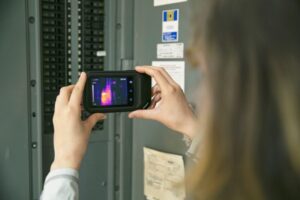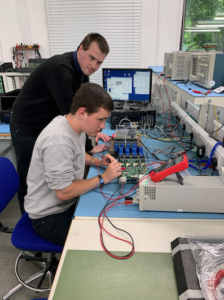The Secure Edge Data Centre (SEDC) is an all-in-one plug and play industrial data centre solution that is specifically designed to run in industrial environments, bringing enterprise-grade IT capacity closer to the point of data collection and machine control. 
Developed in partnership by Rittal, Hewlett Packard Enterprises and ABB, the SEDC supports all the critical systems of a full-size data centre in a 19-inch server rack to reduce environmental and power-outage risks.
The manufacturing customer
ABB is a Swiss-Swedish multi-national corporation headquartered in Zurich, Switzerland. The company operates primarily across robotics, power, heavy electrical equipment, and automation technology.
The 40,000 m² ABB Smart Buildings factory in Schaffhausen, Switzerland, manufactures several million miniature circuit breakers per year (among other products). It not only hosts production machines but also a warehouse where imported goods from other ABB factories are stocked and distributed to ABB’s Swiss customers.
The challenge
The factory has frequently upgraded its production and logistic systems to achieve a higher degree of automatization; this includes robots that are fully integrated into its production lines, as well as autonomous storage systems.
While the new technologies enable shorter lead times and higher product quality, they also require appropriate IT infrastructure and systems to operate smoothly, as well as to store and back-up relevant data.
However, in common with many other manufacturing sites which pre-date the development of IT systems, the factory lacked any dedicated space on-site in which to host the IT equipment for their machines.
As a consequence, it was forced to repurpose underused rooms for its IT systems.
The room for the factory’s main IT was fully fitted out to accommodate its IT infrastructure.
However, the back-up IT equipment only comprised a few servers, so upgrading another entire room wasn’t practical or cost-effective, even though the space wasn’t fit-for-purpose.
The main issues with the room were:
- Limited physical security and resiliency against external influences
- The air conditioning systems were not sufficient to ensure stable climate conditions
- No UPS (Uninterruptible Power Supply) systems to ensure continuous availability in case of a power outage
- No fire extinguishing system in the room to protect equipment and plant against fire hazard and damage
- No remote monitoring of environmental conditions inside the room
All these issues collectively placed unacceptable risks on the system. For example, the back-up of the SQL storage system and the factory’s production records ran on the back-up servers, providing a detailed analysis of its production performance, to enable managers to monitor and improve the factory output and its quality scores.
In addition, data pertaining to 80,000 stock items was continuously synched and updated as required to the back-up server. Details such as the relative position of different stock items were compared with the order pipeline, allowing the system to automatically rearrange items as needed to minimise delivery times.
Besides these two systems, there was also a secondary network connection and a redundant core switch to ensure network continuity and availability for the factory.
The solution
The decision was taken to install a SEDC – effectively a room within a room – to store the back-up IT systems.
The SEDC is a secure enclosure, which has been designed and manufactured by Rittal to provide a safe environment for sensitive electronic or electrical equipment.
It has an IP55 rating, ensuring protection against dust and water jets.
A Rittal cooling system maintains optimal climate conditions inside the SEDC any condensate is automatically pumped out. A Rittal monitoring system gives users remote access to climate conditions and provides data on the status of the systems within the enclosure. Rittal also provided the integrated smoke detection and a gaseous fire extinguishing system to protect the IT equipment against fire damage.
To ensure a continuous power supply for the IT equipment, the SEDC features an ABB PowerValue UPS as well as the SMISSLINE touchproof power distribution system (optionally in a redundant or non-redundant configuration).
The power distribution includes an overvoltage protection against surges. In the event of a power outage, the IT systems can run up to seven minutes on the UPS battery. The UPS will also send a signal (via SNMP) to the IT equipment to shut itself down correctly before the battery runs out of power.
All this means the SEDC provides an ideal solution for on-premise IT equipment and systems, even within harsh environments such as a production floor.
The result
By deploying a SEDC, the Smart Buildings factory could provide a secure environment for their back-up IT equipment and systems and addressed all short-comings of their previous IT installation at once.
It also benefited from:
- Lower investment costs: the facility saved c.$25,000 by installing a SEDC, compared to the cost of upgrading another room with individual systems to achieve the equivalent level of protection of the IT equipment. Added to which, project management and system engineering to install these individual systems weren’t necessary, resulting in further savings.
- Faster deployment: because it is a standardized and pre-configured, yet modular and scalable solution, the SEDC could be delivered sooner and deployed faster than that achieved by individual systems. Commissioning the system only required power and data connections, plus the installation of an external chiller.
- Lower operating costs: air conditioners had to cool down the whole room and could not guarantee the stable climate conditions required by IT equipment. The SEDC, by contrast, only needs to manage the contained air inside the enclosure and so both humidity and temperature can be tightly controlled. Its internal, state-of-the-art cooling unit is also more efficient, which results in around 15-20% energy savings for cooling.
- Lower CO2 emissions: the reduced energy consumption for cooling directly translates into 15-20% lower CO2 emissions by lowering the electricity requirement, so the SEDC also improves the ecological footprint of the Smart Buildings factory.
- Increased security: while the previous server cabinet was half-open, the SEDC represents a contained environment and provides physical protection against external impacts (including ingress of dust and water). Meanwhile, the integrated alarm function informs the factory’s IT team about unauthorised access in real time. To ensure optimal fire protection, the integrated fire detection and extinguishing systems are connected to the factory’s fire detection system and immediately send out an alarm to key stakeholders when it is triggered.
- Lower risk of failure of the IT equipment: the remote monitoring systems provide live data about the status of the SEDC and send warnings about any changes to the enclosure’s internal environment. This enables predictive intervention and maintenance to be carried out, and gives the owners more opportunity to respond, while at the same time, reducing any downtime of the IT equipment. In addition, the uninterruptable power supply system ensures the IT equipment continues to work in the event of a power outage.
Why choose the SEDC?
The SEDC combines all the core elements of a full-sized data centre within one rack, making it the ideal, off-the-shelf solution to upgrade the factory’s on-site IT infrastructure and systems to optimal standards.
It allows the Smart Buildings factory’s systems to safely process data at the edge – instead of in the cloud – and protects the facility against issues related to latency, bandwidth, security, regulatory compliance etc. This enables real-time analysis and rapid, automated response, and reduces the factory’s external network traffic.
Ultimately, the SEDC ensures a higher availability of, and increases safety around, the IT equipment, improving the factory’s performance.
Secure Edge Data Centre specifications
- International protection IP55
- Infrastructure redundancy: 1N IT
- Cooling capacity: 5 kW
- Number of enclosures: 1
- Usable space: 41 U
- UPS autonomy time (full load): 7 min
- Environmental monitoring
- Fire detection
- Dimensions (with casters): 800x1200x2250 mm
- Automatic dispensing of cooling condensate

 Instrumentation Monthly Test | Measurement | Control
Instrumentation Monthly Test | Measurement | Control









